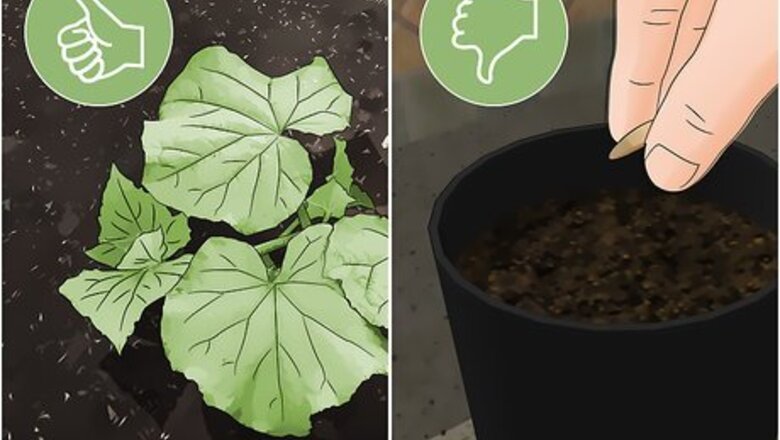
views
Discouraging Beetles with Planting Techniques

Transplant cucumber plants into the ground instead of planting seeds. If you grow cucumbers from seed, start them inside. When cucumbers are first sprouting, they are more likely to be permanently damaged by these beetles. Starting them inside helps them get large enough to be more resilient against these pests.
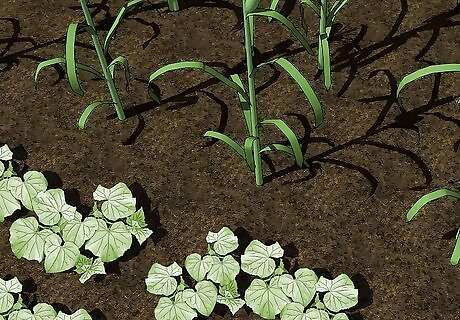
Plant cucumbers with corn and broccoli to discourage the beetles. Intercropping is the practice of planting different kinds of plants together instead of keeping them in separate groups. When planted with crops like corn and broccoli, cucumbers aren't as attractive to the beetles. Plant the cucumbers in rows with corn and broccoli, planting cucumber every third plant. You can also add corn and broccoli between rows of cucumber. Make sure you're still leaving enough space for each plant to grow. Other plants you can try include radish, buckwheat, and sweet clover.

Plant a buttercup or Blue Hubbard squash near the edge of the crop. Beetles tend to stay at the edges of the garden. If you plant something else they like better there, they will stick to it instead of destroying your main cucumbers. Basically, you're sacrificing the plant near the exterior to save your cucumber plants, which is called using a trap plant. You can also treat the trap plant with insecticides to help rid your garden of the beetles. You can also plant other varieties of winter squashes in the Cucurbita maxima family, such as turban squash. Zucchini are also tasty to these beetles.

Apply straw mulch to discourage the beetles and encourage spiders. Straw mulch provides a physical barrier to the beetles, though it won't keep them out completely. However, wolf spiders like to hide in the straw, and they will eat the beetles as they pass through. Sprinkle the mulch in a layer that's about 1-inch (2.5-cm) thick around the young plants, leaving 2 to 3 inches (5.1 to 7.6 cm) around the plant on all sides. Plastic mulches may also discourage beetles.

Change the position of your cucumbers from year to year. Moving your cucumbers to a new spot next year will help discourage beetles a little. If there is a barrier such as a hedge in between, even better. However, beetles will eventually find the new spot.
Removing Cucumber Beetles
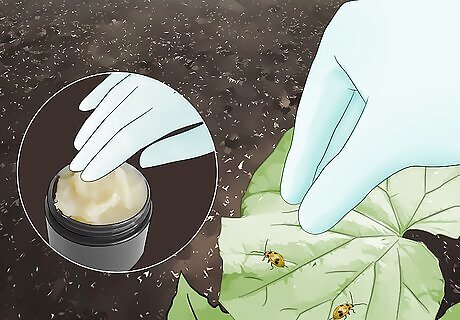
Pick the beetles off by hand using gloves coated in petroleum jelly. These bugs are not the easy to pick off one by one. However, using petroleum jelly makes your glove sticky, which helps pull the beetles off the plant. These beetles have a yellow body with black stripes or black dots. They measure 0.25 inches (0.64 cm) in length. Drop the beetles into a bucket of water with a couple of spoonfuls of dishwashing liquid.
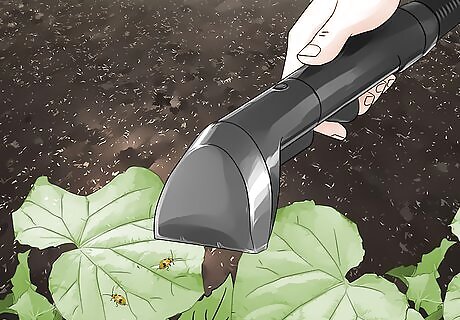
Suck up beetles with a vacuum. You can use a simple handheld vacuum to suck beetles off the plants. Alternatively, use a reversed leaf blower to suck the beetles out. You can also buy a vacuum specifically made for insects if you're worried about harming the plant, as these are generally less powerful. Vacuum all around the plant, including the underside of leaves. Make sure to empty the vacuum when you're done. Seal the contents in a zip-top bag, and take them to the trash.
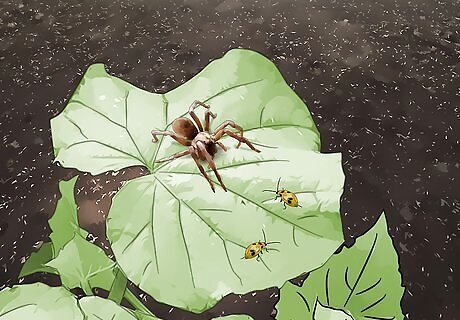
Leave the spiders in your garden. It may be tempting to take out spiders you see, but they are natural predators for pests like cucumber beetles. Wolf spiders, in particular, eat a large number of these beetles, and the beetles tend to avoid the area if there are wolf spiders around. Of course, you should still be careful around spiders. By and large, though, if you leave them alone, they'll leave you alone. Wolf spiders are venomous, but they usually just cause some redness and swelling when they bite you. They aren't as harmful to humans as spiders like black widows or brown recluses.
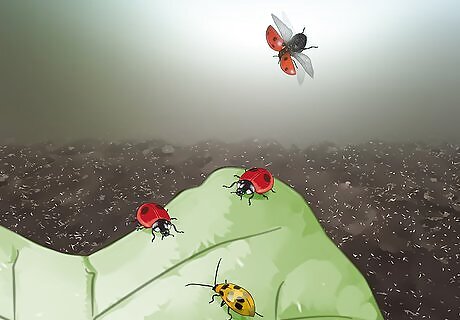
Introduce a predator like ladybugs. Ladybugs take care of a number of garden pests, including cucumber beetles and aphids. In the case of cucumber beetles, the ladybugs eat the pests' eggs, discouraging growth. Start with 1,500 ladybugs for a typical home garden, though you won't harm your garden by releasing too many. Many organic garden stores sell ladybugs to release in your garden. Place the ladybugs in your refrigerator when you buy them, which will slow them down a little. Spray down your yard thoroughly, and release the ladybugs in the evening. Taking these precautions will help keep them in your yard.
Preventing Cucumber Beetles
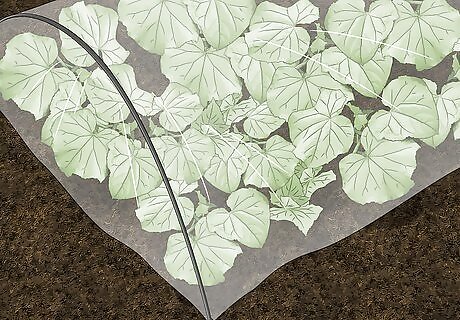
Add floating row covers to keep the beetles out. Floating row covers are basically tiny greenhouses made of plastic that cover an entire row. They let light, water, and air in, but they keep pests out. When placing row covers, cover the edges with soil so that the beetles can't get underneath them and into your plants. Remove them when your plants start to flower so that pollinators can visit the blooms and pollinate your plants.
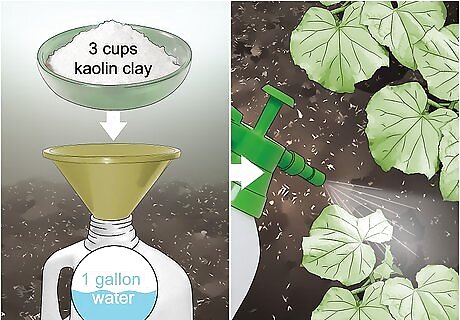
Spray kaolin clay on plants. Kaolin clay is a natural deterrent that creates a surface the beetles don't like. Mix 3 cups (0.71 L) of the powdered clay with 1 gallon (3.8 L) of water. Spray the clay on the plant, making sure to get both sides of the leaves and the stems. This amount of spray will cover about 400 square feet (40 sq. m) of plants. Pick a cloudy day to spray so the water doesn't magnify the sun, burning the leaves. After a heavy rain, check to see if you need to reapply the mixture. Kaolin clay is even safe to spray on the cucumbers. Just wash it off before eating the vegetable. It's also good for other pests, such as grasshoppers, squash bugs, and other beetles so consider applying it to other plants. Eggplants, potatoes, and Brussels sprouts may benefit from being sprayed.
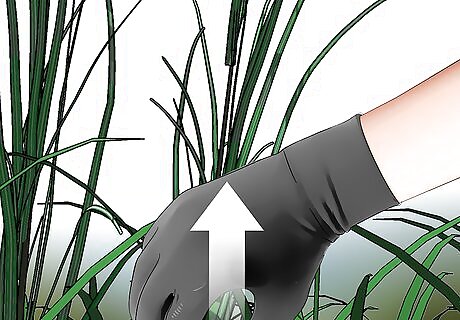
Remove dense grass after you harvest cucumbers. If you've seen these beetles on your plants, they'll likely pop up in your garden next year, too. After you harvest your cucumbers, take away sites that these beetles would hide in over the winter, such as dense grass, and you'll end up with fewer next spring. Also clear away any leaves or other garden trash. Basically, you don't want to leave hiding places near the cucumbers for these beetles to hang out in.



















Comments
0 comment